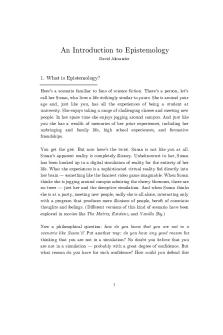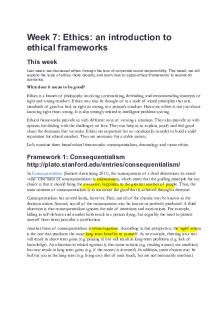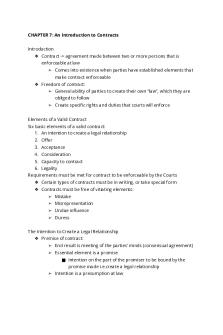Week 7 Ethics an introduction to ethical frameworks PDF

| Title | Week 7 Ethics an introduction to ethical frameworks |
|---|---|
| Author | Jane Cresswell |
| Course | Critical Thinking in Management |
| Institution | Swinburne University of Technology |
| Pages | 4 |
| File Size | 154.4 KB |
| File Type | |
| Total Downloads | 94 |
| Total Views | 137 |
Summary
LEARNING MATERIALS AND ACTIVITIES...
Description
Week 7: Ethics: an introduction to ethical frameworks This week Last week, we discussed ethics through the lens of corporate social responsibility. This week, we will explore the topic of ethics more broadly, and learn how to apply ethical frameworks to real-world scenarios.
What does it mean to be good? Ethics is a branch of philosophy involving systematising, defending, and recommending concepts of right and wrong conduct. Ethics may also be thought of as a code of moral principles that sets standards of good or bad, or right or wrong, in a person's conduct. However, ethics is not just about knowing right from wrong. It is also strongly related to intelligent problem-solving. Ethical frameworks provide us with different ways of viewing a situation. They also provide us with options for dealing with the challenges we face. They can help us to explain, justify and feel good about the decisions that we make. Ethics are important for us vocationally in order to build a solid reputation for ethical conduct. They are necessary for a stable society. Let's examine three broad ethical frameworks: consequentialism, deontology and virtue ethics.
Framework 1: Consequentialism http://plato.stanford.edu/entries/consequentialism/ In Consequentialism (Sinnott-Armstrong 2011), the consequences of a deed determines its moral value. One form of consequentialism is utilitarianism, which states that the guiding principle for any choice is that it should bring the maximum happiness to the greatest number of people. Thus, the main concern of consequentialism is to maximise the good that is achieved through a decision. Consequentialism has several limits, however. First, not all of the choices may be known to the decision maker. Second, not all of the consequences may be known or perfectly predicted. A third objection is that consequentialism ignores the role of intentions and motivations. For example, killing in self-defence and murder both result in a person dying, but arguably the need to protect oneself from harm provides a justification. Another form of consequentialism is ethical egotism. According to this perspective, the 'right' action is the one that produces the most long-term benefits to yourself. As an example, cheating on a test will result in short-term gains (e.g. passing it) but will result in long-term problems (e.g. lack of knowledge). An objection to ethical egotism is that some actions (e.g. stealing money) are unethical, but may result in long term gains (e.g. if the money is invested). In addition, some choices may be bad for you in the long term (e.g. living on a diet of junk food), but are not necessarily unethical.
= CONSEQUENTIALIST TELEOLOGICAL: (J THOMAS WHETSTONE, 2001) place greatest priority on the consequences of acts. NOT IN WORDED AS THIS IN OUR LEARNING MATERIAL
Framework 2: Deontology http://plato.stanford.edu/entries/ethics-deontological/ Deontological ethics (Alexander & Moore 2012) is a framework related to moral obligation to take a particular action, or to refrain from actions. It comprises a set of rules that say that we should or should not do something. The moral rightness of an action is related to its adherence to rules. There rules come from a number of sources. They include religious sources, which frequently prescribe rules of conduct (e.g. one should not steal). These rules also come from cultural sources, such as the expectation that one should not stand too close to another person. They also come from moral intuition, which refers to the feeling that something is inherently right or wrong (e.g. it seems wrong to torture small animals). The philosopher Immanuel Kant also argued that duty came from a standard which he called the 'categorical imperative'. Kant argued that a moral proposition (e.g. 'It is permissible to steal') should be tested in two ways. First, a person should conceive a world in which all rational agents were governed by the same rule, and imagine the implications of this. Second, rational beings should not be exploited to achieve some other end. Finally, Kant also argued that people should act upon rules that a community of rational agents would find acceptable. Deontology has several limitations. First, it is not always clear how to deal with competing obligations (e.g. the duty to be honest, versus the duty to be kind). A second criticism is that deontology deals in moral absolutes, and there may be some exceptions to even very black-andwhite moral laws. For example, stealing to feed one's starving family may be considered a permissible exception to a moral rule against theft. In addition, it is not clear which obligations to adopt, given that different cultures and religions emphasise different imperatives.
Framework 3: Virtue ethics http://plato.stanford.edu/entries/ethics-virtue/ Virtue ethics (Hurthouse 2012) are focused less on outcomes and duties. Rather, this approach to ethics focuses on the development of positive character traits, which are referred to as virtues. Some virtues include: honesty, loyalty, dedication, courteousness, kindness, courage, humility, generosity and wisdom. An advantage of virtue ethics is that this framework allows us to consider the motivation behind an action, such as murdering someone for gain, versus killing in self-defence. It also allows an individual to define a set of values that are important to them. These virtues guide a person to understand what is right and wrong, and they influence their actions. Sometimes, a person will draw on virtue ethics by considering a moral exemplar and imagining what
they would do in that context. For example, they could think: 'An honest person would not infringe copyright; therefore I should not illegally download movies'. A problem with virtue ethics is that it's impossible to distinguish which virtues are the important ones. There is also the problem that some cultures value some virtues more than other cultures. A second problem is that sometimes one virtue can contradict another. A third objection is that the virtue ethics framework focuses only on the actor rather than their actions. Chapter 12 Moral, legal and aesthetic reasoning, pp. 390–425 of your eText, will help you get a more thorough picture of how to use ethical frameworks to make decisions. How virtue fits within business ethics (Whetstone 2001), pp. 1–14, is a nice introduction to virtue ethics, and how it can combine with other ethical frameworks. “A business manager, properly exercising his or her role at the intuitive level of practice, exercises and hones virtues such as courage, temperance, humility, trustworthiness, diligence, love, patience, and practical judgment in applying a principle-grounded ethic to workplace decisions.” P.106 “The excellent manager overcomes pressures to compromise even newly acquired values, at times even opposing and then changing his or her habitual behavior.” P107 “Adding a virtue perspective as a complement to act-oriented perspectives can expand to scope and perspectives of ethical analysis and understanding. This is because an Aristotelian virtue perspective is personal; focuses on the motivations of the actor and the sources of action, bringing a dynamic to ethical understanding; is contextual, highlighting the importance of understanding the environment as it affects both actor and his or her acts; and complements other disciplines addressing human behavior.” P111
Activity: Workplace childcare Purpose To practise applying moral frameworks to real-world scenarios. This activity supports ULO 3 and ULO 4.
Task 1. Read the following scenario (adapted from Coutermarsh 2014). (10 minutes)
Many parents of young children are forced to take time away from work to look after their children. As a result, talk is turning to ways of making working and having children more compatible. The proposed solution: establish a child care centre in the workplace, and allow employees to use it free of charge. Proponents argue that it would make the organisation more attractive to parents and increase productivity through relieving stress. Critics of the scheme argue that it would be expensive for the company, thereby undermining the company's profits and ability to offer competitive salaries. They also argue that it's a special perk that will only be enjoyed by a minority of employees.
2. Choose a moral framework, and write a post for the discussion board examining the issue of the child care centre from this perspective: a. Should the organisation set up a child care centre? b. Should they do something else (or nothing at all)? Consequentialism Utilitarianism, for the greater good, would be pro-childcare when there has been sufficient attention draw to the issue as being a problem. If there were not a problem, there would be no need for discussion on work-&-having children compatibility. We’d conclude that the majority of people would be happy that a life-style choice is not interrupting the efficiency of the company. Ethical egotism, of long term benefit to yourself, would be a persuasive reason to be employed by a company that provides on-location childcare if an employee is the carer of pre-school children. This scenario would work with both parents and grandparents. The standard of care provided would be on-site monitored by those concerned, and users would be more inclined to give financial input to maintain the facility. The scenario does not provide us with any evidence in a specific situation, it is only general. 3. Practise defending your position. Ask your fellow students questions to draw attention to potential holes in their argument, and reply to the questions asked of you. (15 minutes) Aim to post your initial response by the end of the day Wednesday. Return to the discussion board to reply after that, joining the discussion by the end of the week....
Similar Free PDFs

Introduction to Research Ethics
- 40 Pages

An introduction to Psychology
- 4 Pages

An introduction to sociolinguistics
- 451 Pages

1. An Introduction to Epistemology
- 10 Pages

1. An Introduction to Glaciers
- 6 Pages
Popular Institutions
- Tinajero National High School - Annex
- Politeknik Caltex Riau
- Yokohama City University
- SGT University
- University of Al-Qadisiyah
- Divine Word College of Vigan
- Techniek College Rotterdam
- Universidade de Santiago
- Universiti Teknologi MARA Cawangan Johor Kampus Pasir Gudang
- Poltekkes Kemenkes Yogyakarta
- Baguio City National High School
- Colegio san marcos
- preparatoria uno
- Centro de Bachillerato Tecnológico Industrial y de Servicios No. 107
- Dalian Maritime University
- Quang Trung Secondary School
- Colegio Tecnológico en Informática
- Corporación Regional de Educación Superior
- Grupo CEDVA
- Dar Al Uloom University
- Centro de Estudios Preuniversitarios de la Universidad Nacional de Ingeniería
- 上智大学
- Aakash International School, Nuna Majara
- San Felipe Neri Catholic School
- Kang Chiao International School - New Taipei City
- Misamis Occidental National High School
- Institución Educativa Escuela Normal Juan Ladrilleros
- Kolehiyo ng Pantukan
- Batanes State College
- Instituto Continental
- Sekolah Menengah Kejuruan Kesehatan Kaltara (Tarakan)
- Colegio de La Inmaculada Concepcion - Cebu










